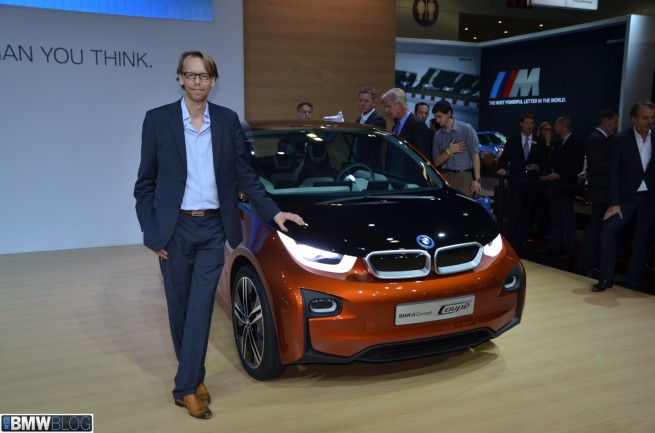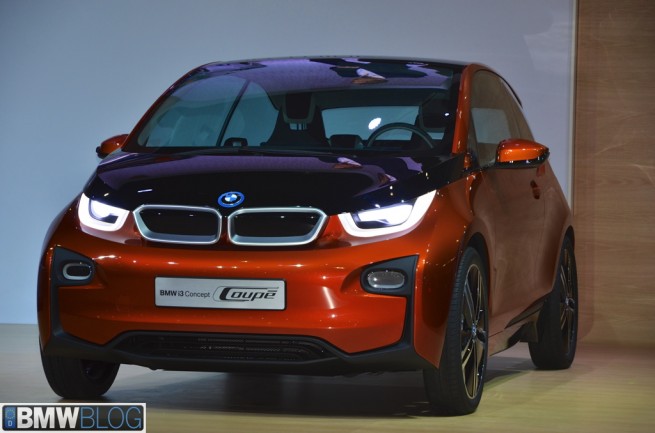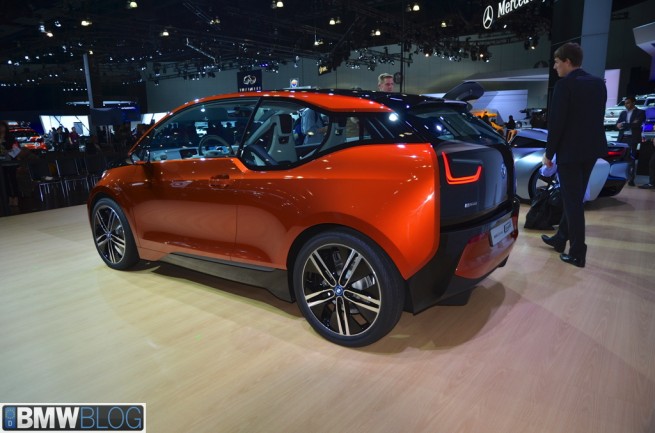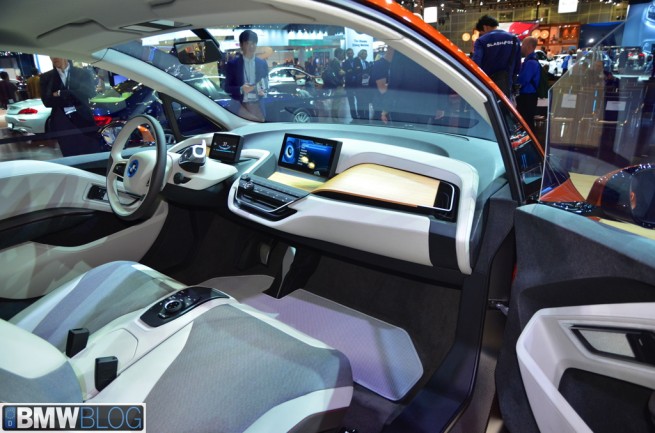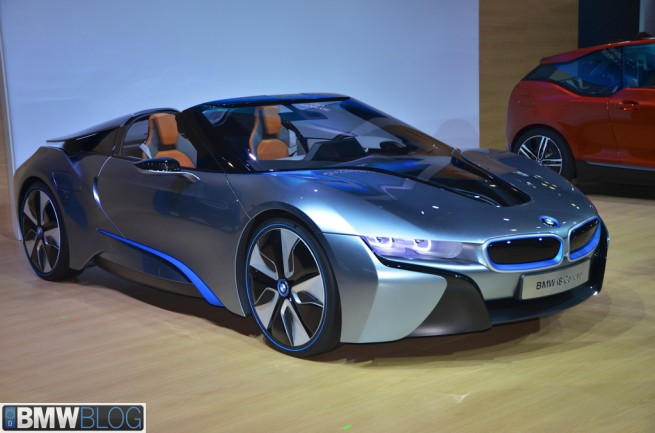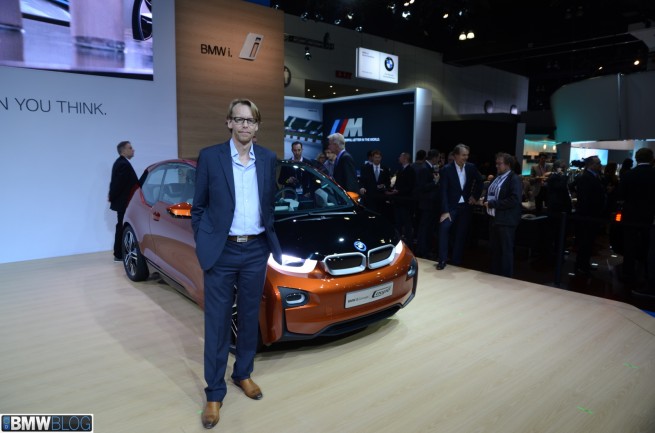BMW i’s Head of Design, Benoit Jacob came to the 2012 LA Auto Show to introduce to the world the BMW i3 Coupe. The two-door electric vehicles builds atop the four-door variant introduced two years ago and exhibited at events and car shows around the world.
Jacob was named in charge of BMW i design in 2008 and according to him, it is one most fascinating and rewarding jobs in the world. Very few designers have the opportunity in their work life to shape up the design language of a new sub-brand.
To learn more about BMW i, mobility, sustainability and the emotional hybrid sportscars, BMWBLOG sat down with the French-born designer for an exciting interview.
BMWBLOG: BMW is known for making premium cars. How would you define the BMW i cars in the same context? What’s really an “i” car?
Benoit Jacob: BMW i stands for innovation, intelligence, inspiration; this little letter next to this famous name BMW makes a big difference; it gives us a certain level of freedom to provide some new answers when it comes to future mobility.
BMW i is also a premium brand, but we want to give to premium a new meaning – this is what we call “next premium”, which in a way demonstrates/aims at showing that premium is not always about adding more. Today we understand premium typically as with more leather, more chrome, etc. Here probably we can address the idea of premium, not about our match, but about how well we do things.
We also have to deal with the new technologies, with the materials in a very authentic manner. When it comes to premium, our aim is essentially effectiveness. When we talk with electric cars about efficiency, aerodynamic, lightweight, these are very rational aspects. But you have to bring them or combine them together with a great deal of desirability, which of course leads to an effective solution, because if you only have efficiency but no love into it, it is not really effective.
You may have a zero-emission car, but that no one wants. So basically our job, together with Adrian Van Hooydonk, is to make sure that this also will appeal to people, and that’s part of the premium experience.
BMWBLOG: How did the idea of BMW i3 Coupe come to life?
Benoit Jacob: We decided to do this show car with two messages.
One of them is the Coupe, a variant that can offered through technology. The LifeDrive concept is quite flexible and this is something that from a design standpoint we believe could be also an additional answer to the i3 family. Additionally, we are now one year away from the production car; it will hit the streets in the last quarter of next year and the show car takes you a bit closer to the final look of the production car.
For example the window graphic is now quite assimilated – it has no longer huge window surface, we did back then with a shortcut to show the advantages of LifeDrive and what you can do from an interior design perspective. We now integrate safety and comfort also into the door which gets to be more closed, it offers more privacy. But we didn’t quite lose the original design. One can see for example on the rear window that we wanted to achieve a very transparent greenhouse, very airy, because that comes back to the idea of Coupe, which are in a sense very emotional cars – more emotional than normal cars.
We said “Can we redefine the idea of emotion specifically for i?” So it’s not only about through proportions but it’s also through the story that you can see for example through this very airy greenhouse.
BMWBLOG: Anything specific that is different on the coupe than the four-door?
Benoit Jacob: You see that now we have a very strong identity that we’ve been launching with early show car, you’ll find it back on this car and we have a good story that we want to develop in a very consequent manner. It would not be sustainable that every six months or every year to come out and say “Sorry, we had an experiment”, and now it’s important to walk the evolution into revolution.
BMWBLOG: How long did it take to design the i3 and i8 cars? We know it usually takes from 5 to 7 years, for the regular cars.
Benoit Jacob: That is correct. We have been a bit quicker tackling this additionally technical challenge we had overcome. I would also say I’ve been lucky to be part of the project from the beginning, since 2008 in charge of BMW i design, and it took us five years to develop the car.
The interesting fact is that we had to develop the show cars and the production cars in parallel, so the production car did benefit from some ideas of the show car. This has played together really well.
BMWBLOG: Are there any design elements that you think will become iconic for “i”?
Benoit Jacob: I would say what makes the BMW i design so special is the way you deal with the surfacing. That expresses a lot of cleanliness, precision. We have a Z-line but we made it a bit more “cleaner”. With the surfacing you have a lot of motion; it expresses a lot of cleanness, a lot of clarity.
Also, what makes the design very special is a contrast between what we call the layers and elements on the body, and the graphics like the screenfloor, the black belt, the carbon roof, and of course that contributes to making the design appearing much lighter. We want to celebrate lightweight through design. This is again what you see through the greenhouse: the car is quite tall from proportions but actually doesn’t look so heavy.
What is so special also is the way we deal with some light elements, for example we integrate the taillight into these glass surface. You can see that there is no shut line (Note: the necessary clearance gap between two adjacent exterior body panels or interior trim panels, either of which may be openable), it’s all integrated, very clever. It’s very important to qualify all these aspects – Is this premium? Is this clever? Is this looking clean?
BMWBLOG: Sustainability is a keyword at BMW. Where do you see sustainability in your cars?
Benoit Jacob: I would say there are different levels of sustainability. You can address the idea of sustainability by adding more efficiency, more lightweight – we have a great deal of carbon fiber in the car. If we move to the interior, we can use a lot of materials made out of natural fiber, or plastics made of natural fibers, or the trims from the seats that come from recycle materials. This is one level of understanding sustainability.
Even more interesting, we were wondering from a design standpoint what is our contribution, other than material – can it also be through the character of the car? If you look at the interior, it is very calm, very relaxing. We believe that when it comes to electric vehicles, range is always critical; you can make it better through technology, through lightweight for example, but maybe a part of the solution lies into people, not always into technology.
What if the interior design would trigger a totally different driving behavior, more responsible, more effective? This is not the car that you want to drive damn quick – it can, but it’s kind of relaxing, a city car, and this can also give you the extra mile.
So this is also an aspect of the sustainability at a deeper level.
BMWBLOG: So the i3 and the i8 are the first cars to take advantage of the full layering design.
Benoit Jacob: We tried to separate two elements, main components in the interior; one is in dark, in these natural fibers – in what we call the “sphere” and then all the layers that you were mentioning here appearing in light color are for us like elements. Like in the house/ loft, sometime I compare this car to a small loft on four wheels. We can combine rough materials with very refined materials – that’s the kind of house I’d like to have, and you find it back in this car.
BMWBLOG: How do you see the future of automotive design? You’re at the cutting edge with the “i” brand, so how do you envision cars in the next 10-20 years? Because clearly this is moving away from conventional cars, it’s all more technology driven.
Benoit Jacob: I don’t have a crystal ball, but as car designers we can of course try to see a bit well in advance. We don’t know if it’s the truth; I can only tell you my personal belief.
I think there is space for a lot of various takes, when it comes to the future. In 10 or 20 years we will probably still see some conventional cars, but I think the world is ready also for totally different solutions, especially when it comes to car design, to character. The interior of the i3 Concept is very much influenced by product design, furniture design, but can work quite well also under this brand. No one really asked for this type of design, but unless you show that is actually possible, probably the demand will exist after all.
We believe it is possible to define emotion in a totally different way, to define the idea of freedom – which are essentially the basic components of the car – in a totally different manner, and I hope in the future we’ll see more of these other things. I hope we can also influence some more colleagues to do so.
I think that what we have to work out is that we can offer very small contribution to change the idea of mobility. “i” stands also for innovation, mobility, not only the car alone, but also all the program mobility service that you can put next to that – that’s designing the eco-system. We cannot do these alone, we need to do with all the partners, architects, urban planners, politicians, etc, but at least we are showing that we are totally dedicated to doing so, and I believe this is a very strong signal from the industry to basically say “Now we are on our way to do that – let’s do that together”.
BMWBLOG: What makes the BMW i8 such an emotional car?
Benoit Jacob: [laughing] I would need a whole day to explain that.
First, it’s the idea that you can still combine in the future the beauty, performance, and responsibility altogether. Most of the people buying this sort of cars play a social role, they are people owning companies or they are in the media, so they enjoy performance and they also want to enjoy probably a much cleaner, a more responsible image and this is that the i8 will offer – probably the first one of its kind. Being more responsible should not be a compromise, we shouldn’t give up the good things, no one is ready for that.
Of course the proportions are stunning, sitting like the i3 on these large wheels, the proportions are something not specific to BMW i, it’s part of the BMW traditions – we have to offer perfect proportions, perfect stance. We do that in a bit more dramatic way, we basically make aerodynamic sexy, because this is also for us like an aim – aerodynamic, which had a very strong focus on the i8 development. We know since the ’30s how to do aerodynamics, simply do a teardrop and you have a highly aerodynamic car. But will it be attractive? Will it be effective? Looking at the wings, we did a bit of a story and made the whole thing very effective.
BMWBLOG: Benoit, thank you for your time!



